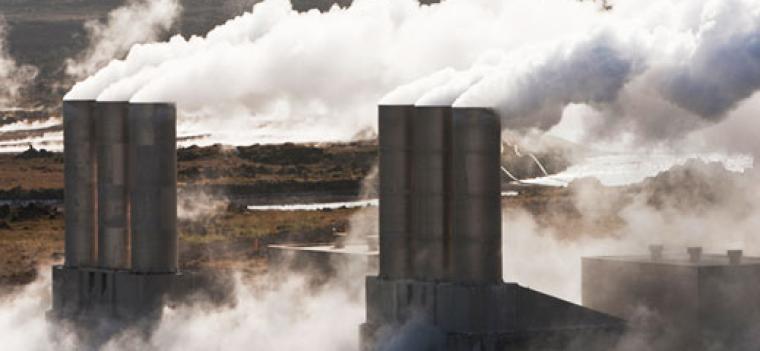|
March 6, 2013
Over a thousand years ago, the Norse settler Ingólfur Arnarson named the capital of Iceland Reykjavik, or “smoky bay” in English, for what he thought was smoke rising from the ground. In fact, it was steam rising from hot springs. A millennium later, Iceland is still tapping this resource. Over 25% of Iceland's electricity comes from geothermal energy. Nine out of ten buildings are heated by waste heat from geothermal power plants.
Iceland is one of about 40 countries with enough geothermal potential to meet a significant proportion of their energy needs. But global potential remains largely undeveloped. To date, geothermal electricity capacity has reached only 11 gigawatts worldwide – only 0.3% of total global power generation.
The main obstacle for geothermal projects has been the initial test drilling phase, which is expensive and risky. Proving the viability of a single steam field can cost US$15-25 million, and if a site has no potential, this investment is lost.
To change this picture, the World Bank is launching a Global Geothermal Development Plan to bring together donors and multilateral lenders around an investment plan to scale up geothermal power in the developing world. The Plan focuses on exploratory test drilling, with the goal of developing a pipeline of commercially-viable projects that are ready for private investment.
 Geothermal energy could be a triple-win for developing countries: clean, reliable, locally-produced power. And once it is up and running, it is cheap and virtually endless. || Sri Mulyani Indrawati, Managing Director, The World Bank Geothermal energy could be a triple-win for developing countries: clean, reliable, locally-produced power. And once it is up and running, it is cheap and virtually endless. || Sri Mulyani Indrawati, Managing Director, The World Bank
Speaking at the Iceland Geothermal Conference in Reykjavik on March 6, World Bank Managing Director Sri Mulyani Indrawati called on donors, multilateral banks, governments and the private sector to join the Plan and bring what is now a marginal renewable energy source into the mainstream to deliver power to millions.
“Geothermal energy could be a triple-win for developing countries: clean, reliable, locally-produced power. And once it is up and running, it is cheap and virtually endless,” said Sri Mulyani Indrawati. “The World Bank Group, and many of our partners, support the goals of the Sustainable Energy for All initiative, led by UN Secretary General Ban Ki-moon and our President Jim Yong Kim. Two of those goals are universal access to modern energy services, and doubling the share of renewable energy in the global energy mix. Geothermal energy will be a major step towards both.”
Many developing world regions are rich in geothermal resources, including East Africa, Southeast Asia, Central America, and the Andean region. Already, the World Bank and Iceland are working together under a “Geothermal Compact” to support surface exploration studies and technical assistance for countries in Africa’s Rift Valley—Tanzania, Burundi, Rwanda, Uganda and Ethiopia are participating with Zambia expected to join soon.
The Global Geothermal Development Plan expands on previous efforts by its global scope, and its focus on test drilling. It will identify promising sites and leverage financing for exploratory drilling, to develop commercially viable projects. The Plan’s initial target is to mobilize US$500 million. Donors can participate by identifying viable projects, and through bilateral assistance, as well as by contributing to existing channels such as the Climate Investment Funds (CIFs) or the Global Environment Facility (GEF). The GGDP will be managed by the World Bank’s longstanding Energy Sector Management Assistance Program (ESMAP).
The World Bank will convene donors later this year to discuss financing of specific geothermal projects under the plan. The Bank Group’s financing for geothermal development began in the 1970s and has increased from $73 million in 2007 to $336 million in 2012. It now represents almost 10 percent of the Bank’s total renewable energy lending.
Geothermal is also the energy source with the smallest land footprint per kilowatt hour, making it especially attractive in developing countries where population densities are high and land is at a premium.
“Until now, our work has been at the country and regional levels,” Sri Mulyani said. “These efforts are important, and should continue. But a global push is what is needed now. Only a global effort will put geothermal energy in its rightful place – as a primary energy source for many developing countries. Only a global effort will pool resources to spread the risk effectively. It will let us learn from each other, from our failures and successes, and apply that learning.”
Resources
|

 Geothermal energy could be a triple-win for developing countries: clean, reliable, locally-produced power. And once it is up and running, it is cheap and virtually endless. || Sri Mulyani Indrawati, Managing Director, The World Bank
Geothermal energy could be a triple-win for developing countries: clean, reliable, locally-produced power. And once it is up and running, it is cheap and virtually endless. || Sri Mulyani Indrawati, Managing Director, The World Bank